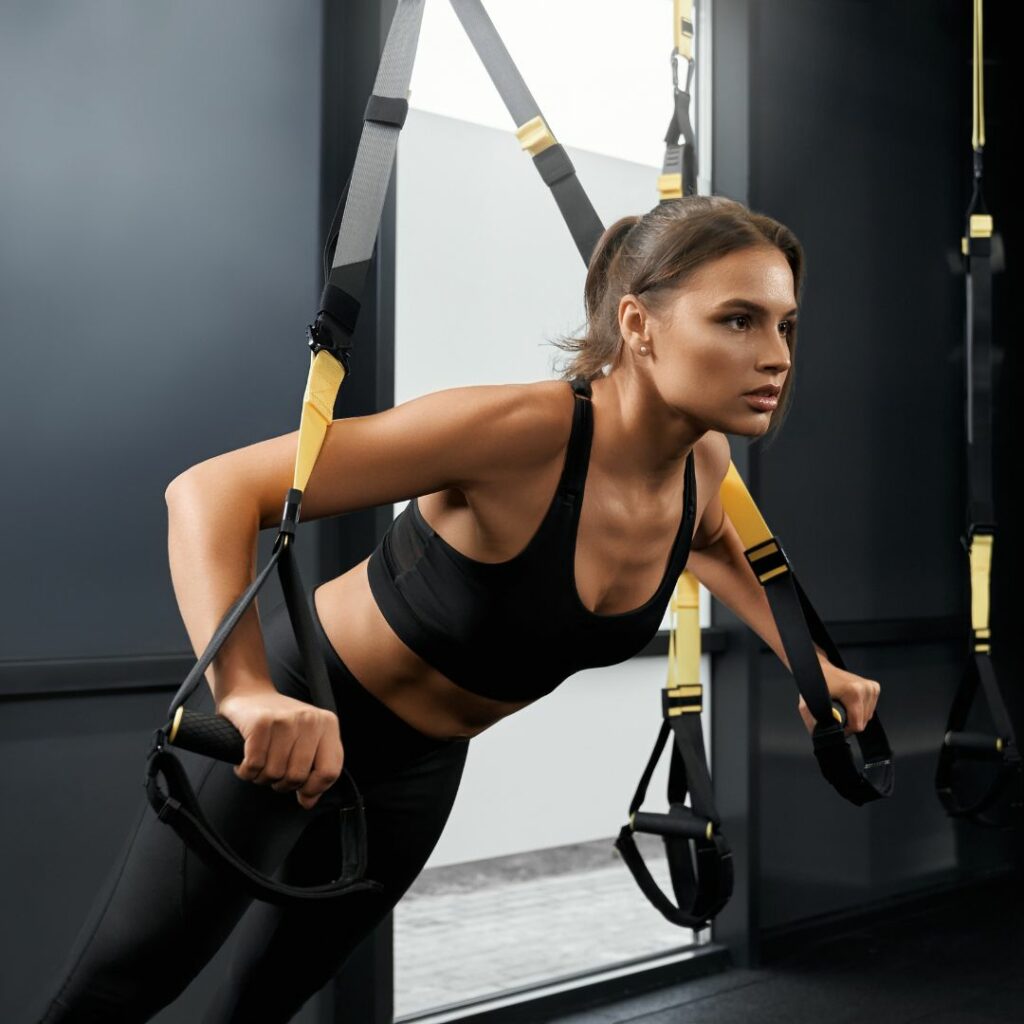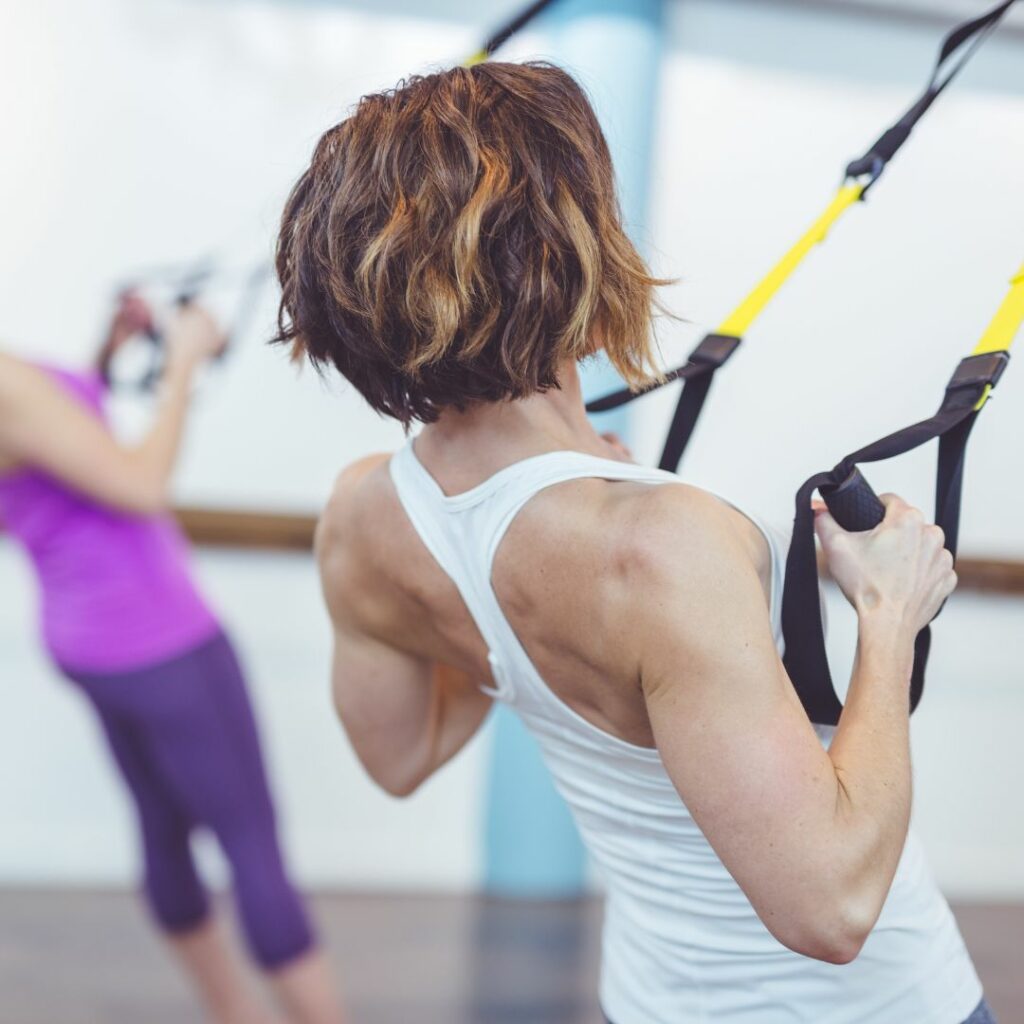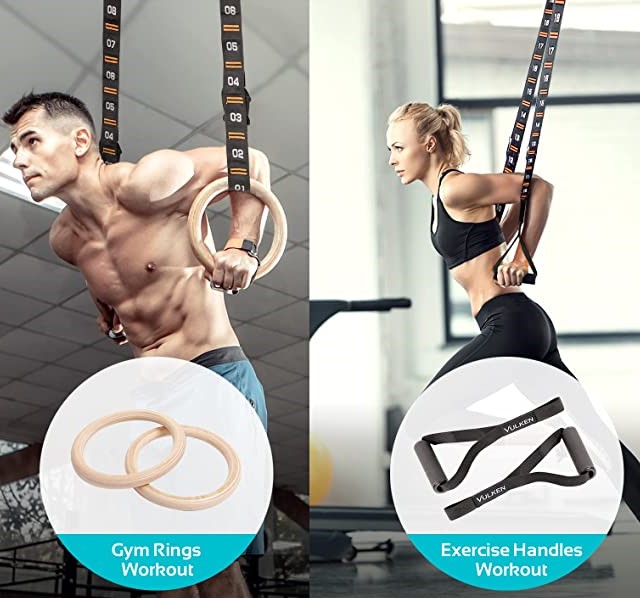In the first article of this series, I described three main criteria that can help us pick the best exercises when strength training with Ehlers Danlos. Exercises that are simple, stable, and congruent allow us to efficiently send a strengthening single to our muscles without wasting time or sustaining injuries. In this article, I want to apply these criteria to identify the best and worst suspension trainer exercises for people with joint hypermobility conditions like Ehlers Danlos (EDS).
What is a suspension trainer, and is it safe if I have EDS?
Suspension trainers include popular options like the TRX, but more broadly are any strap system with gymnastics rings or handles and a high anchor point, such as a door jam anchor, a pullup bar, or a wall-mount. Suspension trainers, like this affordable option by Vulcan, are very convenient for home gyms or for exercising while travelling because they take up very little space. Used properly, they CAN be a safe option for getting stronger, even if your joints are hypermobile. Unfortunately, a great many of the exercises that are popularly done on suspension trainers violate some (or all) of the criteria we described in the last article, and are very bad choices for people hypermobility disorders like EDS.
It would be impossible to catalogue all of the unstable and overcomplicated ways to use suspension trainers. Instead, I will highlight two exercises that do NOT meet the our criteria of simple, stable, and congruent, and then two exercises that do. I hope this will improve the safety and effectiveness of your workouts by showing you some great suspension trainer exercises. And more than that, I hope this comparison will drive home exactly how to apply these criteria to other exercises and training tools, so you can make better choices in your own exercise routine.
The suspension trainer pushup: incongruent and unstable.

This first movement is what I would call a cool gymnastic skill, but not a great muscle strengthening exercise. As you’ll see in the video below, the suspension trainer pushup involves a lot of instability. Like a dip on gymnastic rings, you have to work hard to keep your hands from slipping out to the side. If that were to happen, you could easily hurt your shoulder or fall on the floor and sustain an injury.
Now, someone could say that having to stabilize yourself has benefits. And it’s true that engaging in athletic activities can improve our proprioception. But if our goal is to strengthen the muscles around shoulder, this isn’t a safe or efficient option. There is too much risk, and the lack of congruence means you will be likely to bounce through the hardest (and riskiest) part of the exercise.

A traditional or knee pushup is a better option for anyone with joint hypermobility.
And here’s the thing: regular pushups are MORE than challenging enough. Performed with a slow, controlled tempo and gentle change of direction, the traditional pushup is so difficult that even strong people can use it to get a phenomenal stimulus to their upper body.
In fact, most people new to strength training should probably regress the difficulty of the pushup down to knees. My point is that there is no need to make the pushup overcomplicated and dangerously unstable by performing it on rings.
The suspension trainer row: a simple, stable exercise for joint hypermobility.

The suspension trainer row, on the contrary, meets all of our criteria. It is very simple, requiring only a few form points needed to execute correctly, such as keeping your knees, hips and shoulders in a straight line, and pulling your chest “through” your hands. It is also stable, because your center of mass is under the handles, making losing your balance impossible.
With the row, gravity is pulling you straight down, and so very little balance or coordination is necessary. And even though challenging our balance can be good in general, it also makes it harder to deeply fatigue muscles. Because the row requires little coordination, it makes getting deeply fatigued very straightforward and efficient, as the personal training clients at our studio in Chesapeake, VA know full well!
The suspension row lends itself to good form and safe technique.
And finally, the row is very congruent. You are strongest when your arms are straight in front of you, and this is also when you are most parallel to the ground and feel the strongest pull of gravity. When you are more upright, you feel less of gravity pulling you backwards and down, and this coincides with when you are weakest. The result is a very even level of difficulty, which reduces your instinct to bounce, yank, or otherwise cheat through some part of the exercise. The row checks all 3 boxes, which is why it is one of the best suspension trainer exercises for anyone with joint hypermobility conditions like Ehlers-Danlos (EDS).
Conclusion
Crucially, I am NOT saying no one should ever do a complicated gymnastic skill. There is joy to be had in in expressing your strength by practicing complex and skill-based movments. Traditionally, this is called practicing a sport, and many people accomplish this through strength-type sports like gymnastics or powerlifting. But if you are just trying to improve the health and function of your muscles and joints, sports aren’t the most efficient (or safest) way. A backflip is an amazing skill, but an inefficient and risky way to build stronger hips, thighs, and core muscles. Select simple, stable, congruent options, and you’ll avoid injury and find it easier to stay consistent and get strong.


